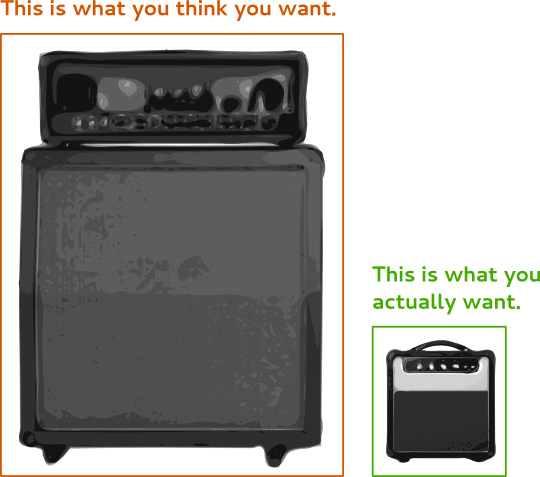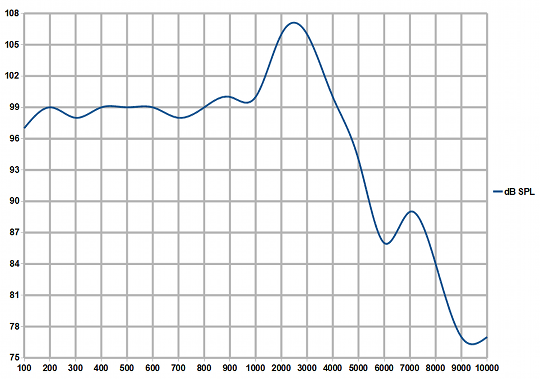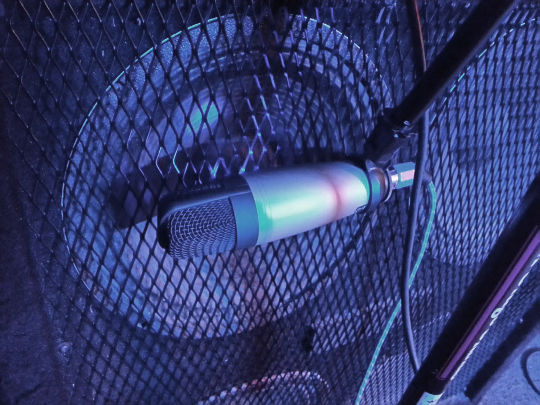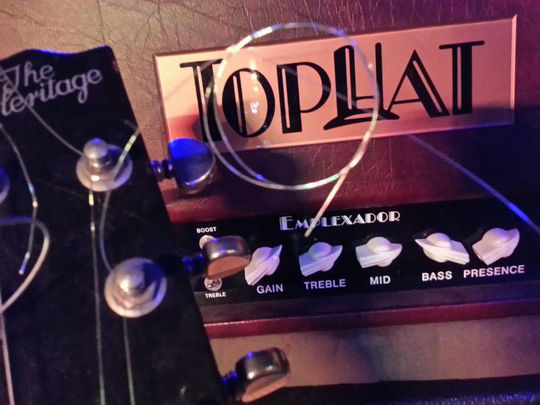Large, powerful amplifiers were necessary in the early days of rock and roll. Not anymore.
Please Remember:
The opinions expressed are mine only. These opinions do not necessarily reflect anybody else’s opinions. I do not own, operate, manage, or represent any band, venue, or company that I talk about, unless explicitly noted.


Nothing screams “Rock Band” like lots of gear. I myself will readily admit it: I LOVE the look of big, “ugly,” powerful, solidly-built amps and speaker cabs. You get all of that into a room, and by gum, everyone knows that you mean business.
Having people think that you mean business is a really good feeling. Heck, it’s an addictive feeling.
But it’s just a feeling.
What counts a lot more than looking like you mean business is to actually mean business, and then prove it beyond all doubt with your actual music. Proving you mean business in the small-venue context doesn’t require a lot of gear. It simply requires that you have enough gear.
Sure, you do want a bit of “cushion” or headroom, but a whole ton of it isn’t necessary. In fact, it can even be detrimental. We’ll get into that in a bit – but first, let’s talk about where the “big gear” thing came from.
The Days Before PA (As We Know It)
Way back when, in the days when men were real men, women were real women, and cars cost about as much as five tanks of gas today, you could count on one general rule for live-sound reinforcement:
You either made enough noise acoustically, or you had a dedicated amp.
The exception to this (but not by much) was the vocalists. Each vocalist might not have had their own PA, but the typical reality was that the PA only had a handful of inputs – and the PA only did vocals. The idea that you would put all the instruments through one sound rig was a foreign concept.
As a result, if you were doing a big show, you needed big amps. The drums might carry pretty well, but if you were going to get that guitar solo all the way to the back row, you needed serious firepower. Even as PA technology grew by leaps and bounds, the notion that guitarists and bass players would make all their own noise stayed entrenched. Hey – they already had the gear, right? Why fix what isn’t busted?
At this same time, the founding fathers of amplified guitar and bass were creating the tones and textures that would define those instruments for decades. They were getting those sounds through gear that had to be big, heavy, and loud to do its job. Especially for the guitar players, who loved (and still do love, for good reason) the thick, satisfying roar of power tubes being driven hard, the acoustical output was in-freaking-sane.
They got away with that volume because it was expected, and also because they were playing to huge crowds. Most of the audience wasn’t in the first few rows, and so the noise wasn’t as deafening.
Now, fast forward to 2013.
The iconic gear that defined the sound of rock and roll instruments is still very much in fashion. Sure, there have been various improvements in materials, construction, cost management, and design, but all of these creatures of the amplifier kingdom are fundamentally the same animals as their counterparts from 1969. They’re big, they’re heavy, and their most rockin’ sounds require stadium volume (or a power soak, if you don’t want stadium volume).
The problem is that stadium volume from amplifiers is no longer required, or even desirable – especially not in small rooms.
The 100 Watt Amp Problem
Let’s talk about some of what’s going on when an all-tube, 100 watt, gorgeous sounding amp is really doing its thing. Let’s make some conservative assumptions to start:
- The 100 watt rating is the continuous power generated by the amp at a full-tilt, maximum overdrive, supersaturated roar.
- The cab is a 4×12, wired so that each loudspeaker gets 25 watts.
- Each loudspeaker has an average sensitivity of 95 dB SPL at 1 watt, measured at 1 meter.
The tone is killer. So is the volume.
Each cone is producing about 109 dB SPL, continuous. The summation of those four cones is 115 dB SPL, continuous, at 1 meter. The average audience member is probably sitting about 22 feet (6.7 meters) away. The venue isn’t totally dead, acoustically, so the average SPL decay is 5 dB per doubling of distance, as opposed to 6. This works out to 13.7 dB of volume decay for the average audience member.
So, for the most part, the audience is hearing about 101 dB SPL, continuous, of just the one guitar. Add another guitar of similar volume, and the continuous level is 104 dB SPL. The bass player fits in with a 99 dB SPL contribution, which takes our total to 105 dB SPL. The drummer is a spirited lad, able to make 100 dB SPL himself. Now we’re at 106 dB SPL. The vocals probably have to be at a minimum continuous level of 102 dB in order to be distinguishable, so that takes us to a grand total of…
Just under 108 dB SPL, continuous, for the average audience member, and that’s not including monitor wash.
For most people, that’s pretty dang loud. In a bar, that kind of level is hard to deal with when placing or taking orders (assuming that the bar is in the “average level” zone – which IS the case in a good number of rooms).
There’s no denying that the tone of the guitar is spectacular, but that spectacular tone is causing an audience discomfort problem, and potentially an economic problem for the venue.
This is bad for you.
Also bad for you is that, to get really good separation, the singer (who’s about 12 feet from the cab) has to be able to produce about 125 dB SPL at their mic capsule. This means that you need a singer with lots of power, stamina, and great pitch control at full volume…or less pitch control, but more raw power in reserve.
On top of that, for the vocalist to feel like they’re really hearing themselves in the monitors, the wedges will need to be making about 115 dB SPL continuous at the singer’s ears. If the singer is really powerful, and the wedges are good, then this should be achievable. If the singer isn’t really powerful, or is having an off day, or if the wedges are a little cheap, getting that kind of level may be a battle. Now, you’ve potentially got gain-before-feedback issues.
The Upshot
That arena-ready amp rig sure does sound good, but:
- It probably costs a fair amount of money to acquire.
- It takes up a lot of room.
- It’s heavy.
- It has to get really loud before it sounds right.
- It forces everybody else to keep up.
- It makes monitors harder to manage.
- It can drive audience members away.
- The venue can lose money.
- It reduces the FOH audio tech’s options for the rest of the band (because the tech’s first priority can be forced towards just keeping up with you).
Bummer.
There’s a fix.
Buy a little amp.
There are plenty of all-tube combos out there that top out at 10 watts. That’s really all that you need. Get those tubes really hot to get the tone you want, and you’ll probably have about 105 – 110 dB SPL at 1 meter.
And you’ll be able to do it with a piece of gear that’s easy to carry.
And you’ll be able to do it with a piece of gear that you can fit anywhere.
And you’ll be able to do it without making your vocalist work themselves to death.
And you’ll be able to do it without forcing everybody else to keep up with you, whether in terms of volume or equipment purposes.
And you’ll be able to do it without flattening the audience.
And you’ll be able to do it while the bar still makes money.
And you’ll be able to do it while allowing the audio tech to make meaningful choices to get you the best sound possible.
And, because PA technology has come a very long way, that one amp will still work for you when you’re playing stadiums. The crew will just stick a mic in front of it, and turn that 10 watt amp into a 10,000+ watt amp with great coverage and smooth frequency response across the entire audience.
I can certainly understand that you might want a big rig because of the way it looks, or because there’s something very specific about the sound that can’t be perfectly replicated by other means. I do get that.
But big amps just aren’t necessary anymore, and they can be more trouble than they’re worth.


 Very reliable, but not the only valid technique.
Very reliable, but not the only valid technique.